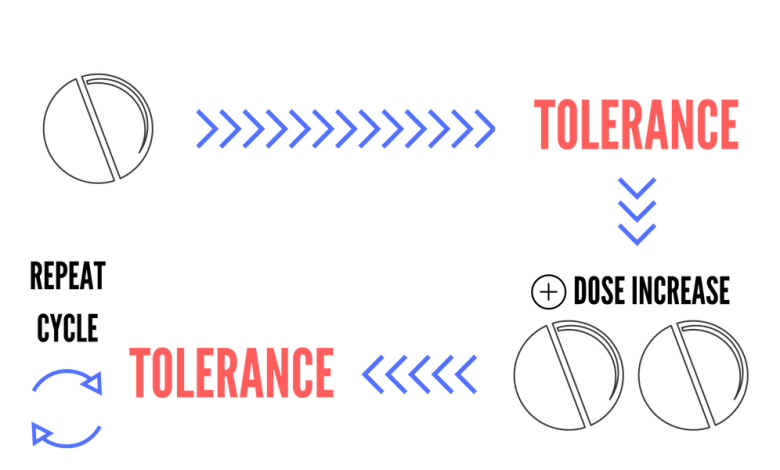Understanding Low and High Tolerance to Drugs

Drug tolerance refers to the reduced responsiveness or diminished effect that a person experiences when repeatedly exposed to a drug. In other words, over time, the body or brain becomes less sensitive to the substance, requiring higher doses to achieve the same initial effect. Tolerance is a common phenomenon observed in both prescription and recreational drug use and can manifest in various forms.
Tolerance to drugs is a complex and multifaceted phenomenon that varies from person to person. It plays a crucial role in the effects of substances on individuals, influencing the dosage required to achieve desired effects or the potential risks of overdose. Tolerance can be broadly categorized into two extremes namely:
Low Tolerance
Low tolerance to drugs refers to an individual’s heightened sensitivity to a substance, where even a small amount can produce significant effects. This sensitivity can be attributed to various factors, including genetic predisposition, individual metabolism, and a lack of prior exposure to the drug as explained below;
1. Genetic Factors: Genetic variations can significantly impact how the body processes and responds to drugs. Some individuals may possess genetic traits that make them more susceptible to the effects of certain substances, leading to a lower tolerance.
2. Metabolism: The rate at which the body metabolizes drugs varies among individuals. Those with a slower metabolism may experience prolonged and intensified effects, contributing to a lower tolerance.
3. Limited Exposure: Individuals who have not been exposed to a particular drug frequently may exhibit a lower tolerance. The body’s ability to adapt to and tolerate the effects of a substance often increases with repeated use.
4. Psychological Factors: Psychological factors, such as anxiety or stress, can amplify the effects of drugs, contributing to a lower tolerance. Emotional states play a crucial role in how individuals perceive and respond to substances.
Implications of Low Tolerance
While having a low tolerance may seem advantageous in terms of requiring smaller amounts of a substance to achieve desired effects, it also poses potential risks. Individuals with low tolerance are more susceptible to adverse reactions, including overdose, as their bodies may not handle even small doses well;
1. Increased Risk of Overdose: Individuals with low tolerance are at a higher risk of overdosing on a drug, as their bodies may not be equipped to handle even standard doses. This heightened sensitivity can lead to unexpected and severe reactions.
2. Unpredictable Responses: Low tolerance can result in unpredictable responses to drugs. What might be a mild experience for one person could be overwhelming for someone with low tolerance, leading to anxiety, panic, or other adverse reactions.
High Tolerance
Conversely, high tolerance refers to a reduced sensitivity to the effects of a drug, necessitating larger doses to achieve the same results. This phenomenon is often observed in individuals who have developed a tolerance through repeated or prolonged substance use.
1. Adaptive Processes: The human body has remarkable adaptive processes that allow it to adjust to the presence of drugs. With regular use, the body may develop mechanisms to mitigate the impact of a substance, leading to a diminished response and the need for higher doses.
2. Neurological Adaptations: High tolerance is often associated with neurological adaptations, where the brain adjusts its receptors and signaling pathways in response to the continuous presence of a drug. This can result in decreased sensitivity to the substance over time.
3. Enzyme Induction: Prolonged exposure to certain drugs can induce the production of enzymes responsible for drug metabolism. This increased enzyme activity can lead to more efficient drug breakdown, requiring higher doses to achieve the desired effects.
4. Behavioral Tolerance: In addition to physiological adaptations, behavioral tolerance can also contribute to high tolerance. Individuals may develop habits or routines associated with drug use, and these contextual cues can influence the perceived intensity of the drug’s effects.
Implications of High Tolerance
While high tolerance can be advantageous for individuals seeking to maintain a certain level of drug use without experiencing overwhelming effects, it also carries risks and potential consequences that include;
1. Increased Health Risks: High tolerance often leads to escalated drug use, putting individuals at a higher risk of substance dependence and addiction. This, in turn, can result in a range of health issues, including cardiovascular problems, liver damage, and mental health disorders.
2. Financial and Social Impacts: The need for larger doses to achieve the desired effects can place a significant financial burden on individuals with high tolerance. Additionally, the social consequences of escalated drug use, such as strained relationships and diminished productivity, can be profound.
Forms Tolerance
Tolerance can manifest in various forms, impacting different aspects of drug effects. Here are the other subtypes of drug tolerance:
- Metabolic Tolerance:
- Definition: Metabolic tolerance occurs when the body becomes more efficient at metabolizing a drug, leading to a decrease in its concentration and effects in the bloodstream.
- Example: Chronic alcohol users may develop metabolic tolerance as their liver becomes more adept at breaking down alcohol.
- Cellular or Pharmacodynamic Tolerance:
- Definition: This type of tolerance results from changes within the cells that reduce their response to a drug. It may involve alterations in receptor sensitivity or signal transduction pathways.
- Example: Opioid receptors in the brain can become less responsive with prolonged opioid use, requiring higher doses to achieve the same analgesic effect.
- Behavioral Tolerance:
- Definition: Behavioral tolerance occurs when individuals learn to adapt their behavior to compensate for the effects of a drug. This type of tolerance is often observed in activities that require motor skills or cognitive functions.
- Example: Individuals who regularly consume alcohol may develop behavioral tolerance by learning to function relatively normally despite the impairing effects of alcohol on coordination and cognition.
- Cross-Tolerance:
- Definition: Cross-tolerance occurs when tolerance to one drug results in a reduced response to another drug with a similar mechanism of action.
- Example: If an individual develops tolerance to one benzodiazepine, they may also exhibit tolerance to other benzodiazepines due to their similar effects on the central nervous system.
- Environment-Dependent Tolerance:
- Definition: Tolerance that is linked to specific environmental cues or settings. The individual may experience reduced drug effects in an environment different from where they usually use the substance.
- Example: Someone accustomed to using a drug in a particular location may experience decreased effects when using the drug in a novel environment.
- Learned or Behavioral Tolerance:
- Definition: Tolerance that results from learned associations between drug effects and specific cues or situations.
- Example: If a person consistently uses a drug in a certain context, they may develop a tolerance specific to that context, and the drug may have a stronger effect when used in that particular setting.
- Pharmacokinetic Tolerance:
- Definition: This type of tolerance is related to changes in drug absorption, distribution, metabolism, or excretion, leading to altered drug concentrations in the body.
- Example: Long-term use of certain medications may induce enzymes in the liver, enhancing drug metabolism and reducing its efficacy.
Understanding the various types of drug tolerance is crucial for healthcare professionals in developing effective treatment plans and interventions for individuals struggling with substance abuse issues.
Conclusion
In the intricate landscape of drug tolerance, understanding the dynamics of low and high tolerance is essential for making informed choices and minimizing potential risks. While low tolerance can lead to heightened sensitivity and increased vulnerability to adverse reactions, high tolerance may contribute to escalating drug use and its associated health and social consequences. By adopting personalized and cautious approaches to drug use, individuals can navigate the delicate balance between achieving desired effects and safeguarding their well-being.
Ongoing research in the fields of pharmacology and neuroscience continues to shed light on the complexities of tolerance, offering hope for more targeted interventions and improved understanding in the future.





